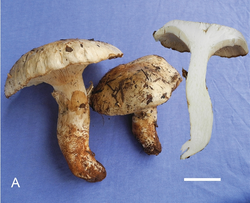Biology:Catathelasma
| Catathelasma | |
|---|---|

| |
| Catathelasma laorentou, China | |
| Scientific classification | |
| Domain: | Eukaryota |
| Kingdom: | Fungi |
| Division: | Basidiomycota |
| Class: | Agaricomycetes |
| Order: | Agaricales |
| Family: | Biannulariaceae |
| Genus: | Catathelasma Lovejoy (1910) |
| Type species | |
| Catathelasma evanescens Lovejoy (1910)
| |
| Species | |
|
C. imperiale | |
| Synonyms | |
|
Biannularia Beck (1922) | |
Catathelasma is a genus of fungi in the family Biannulariaceae.[1] Basidiocarps (fruit bodies) are agaricoid, with a conspicuous veil (leaving a double ring on the stem), adnate to decurrent lamellae, and amyloid basidiospores. The genus is separated on DNA characteristics as well as morphology. Species are known from North America, Europe, and Asia and are ectomycorrhizal, forming an association with the living roots of trees.[1][2]
Taxonomy
The genus Catathelasma was originally described in 1910 by American botanist and mycologist Ruth Ellen Harrison Lovejoy with C. evanescens as the type species.
in 1922 the Austrian botanist Günther Beck von Mannagetta und Lerchenau referred the European species Armillaria imperialis to his new genus Biannularia. For a time Catathelasma and Biannularia were regarded as separate (though closely related) genera, as for instance in a 1936 paper by Rolf Singer.[3] Later Singer united the genera[4] using Lovejoy's earlier name. Recent DNA research confirms this synonymy.[1]
Etymology
Lovejoy's original description states that:[5]
"The ring and volva, together with the very decided decurrent gills (upon which character the generic name is based), are telling characteristics of this genus."
According to Genaust's etymological dictionary of botanical names, "Catathelasma" comes from Ancient Greek words "kata" (κατά - downwards) and "thelasma" (θήλασμα - meaning "the act of suckling"). He says that the reason for this construction is unclear, but suggests that the author is comparing the shape made by the gills running down the stem with a teat stretched out during suckling.[6] "Decurrent" means "running down the stem" and another possible connection with Lovejoy's description is that "katatheo" (καταθέω) means "I run down".[7] However it is difficult to see how that could logically give rise to the noun "Catathelasma".
Description
Catathelasma species are stocky, Tricholoma-like fungi, with adnate to decurrent lamellae (gills), a double veil (giving the stipe two rings), a stipe that is tapered to the base and rooting (often buried), and a mealy smell. At the microscopic level they have oblong to cylindrical, amyloid spores, a bilateral gill trama, and hyphae with clamp connections.[1]
Habitat and distribution
Species are ectomycorrhizal, growing on the ground under conifers. They are known from continental Europe, North and Central America, and Asia.[1][2]
Edibility
Some species of Catathelasma are edible and are collected for food in China, Guatemala, and Russia.[8]
References
- ↑ 1.0 1.1 1.2 1.3 1.4 "Insights into the Tricholomatineae (Agaricales, Agaricomycetes): a new arrangement of Biannulariaceae and Callistosporium, Callistosporiaceae fam. nov., Xerophorus stat. nov., and Pleurocollybia incorporated into Callistosporium". Fungal Diversity 101: 211–259. 2020. doi:10.1007/s13225-020-00441-x.
- ↑ 2.0 2.1 Ge, Zai-Wei; Wu, Jian-Yun; Hao, Yan-Jia; Zhang, Qingying; An, Yi-Feng; Ryberg, Martin (2020). "The genus Catathelasma (Catathelasmataceae, Basidiomycota) in China". MycoKeys 62: 123–138. doi:10.3897/mycokeys.62.36633. PMID 32076385.
- ↑ Rolf Singer (1936). "Das System der Agaricales" (in German). Annales Mycologici 34 (4–5): 317. http://www.cybertruffle.org.uk/cyberliber/59685/0034/004/0317.htm.
- ↑ Singer R. (1940). "Notes sur quelques Basidiomycètes" (in French). Revue de Mycologie 5: 3–13.
- ↑ Ruth Harrison Lovejoy (1910). "Some New Saprophytic Fungi of the Middle Rocky Mountain Region". The Botanical Gazette 50 (5): 383. doi:10.1086/330381. https://zenodo.org/record/1431387. The text can be found on-line at [1].
- ↑ Helmut Genaust (1996) (in German). Etymologisches Wörterbuch der botanischen Pflanzennamen. Gabler Wissenschaftsverlage. p. 134., which may be seen on-line through Google books at [2]. Genaust says "Benennungsmotiv unklar: wahrscheinl. werden die bis auf den Stiel herablaufenden, schmützig-weiß bis blaß-gelblichen Lamellen mit dem Bild einer beim Saugen gestreckten Milchzitze verglichen" - in English "Motive for the naming unclear: probably the dirty white to pale yellowish gills which run down onto the stem are being compared to the image of a teat being stretched out during suckling".
- ↑ Henry George Liddell; Robert Scott (1996). An Intermediate Greek-English Lexicon. Oxford: Clarendon Press. ISBN 0-19-864226-1. See the Perseus Project entry at [3].
- ↑ Boa ER. (2004). Wild Edible Fungi: A Global Overview of Their Use and Importance to People. Food & Agriculture Organization. p. 138. ISBN 978-92-5-105157-3. https://books.google.com/books?id=Zd2NlcNZgvcC&pg=PA138.
Wikidata ☰ Q2707526 entry
 |

